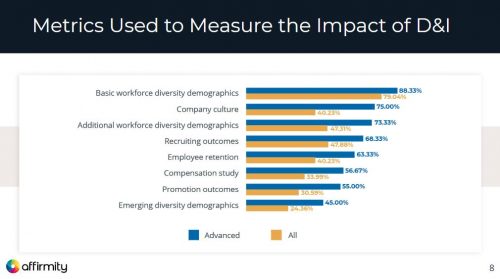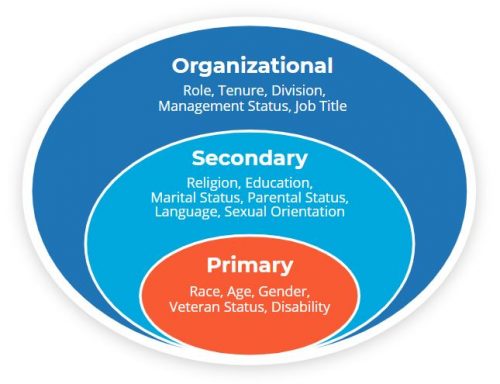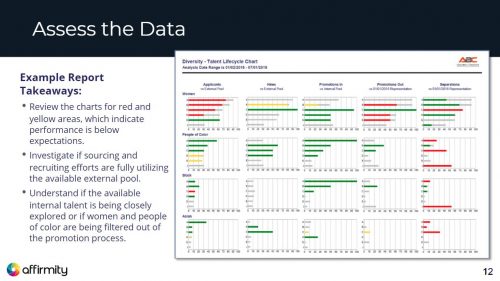The uncertain times we live in mean difficult decisions lie ahead for many organizations. Ensuring that data-driven diversity insights are at the core of your talent lifecycle will help ensure that if these tough scenarios do happen, your decision-making is fair and legal. Read on to find out how to use data in your D&I program as we answer some advanced questions you may have.
The Affirmity team are, as ever, working on bringing you insights on D&I that are relevant to the decisions your organization is facing. We are continuing to run webinars on important topics and on April 16 we held a panel discussion with Affirmity consultants Roy Zambonino, Patrick McNiel, PhD. and Charles McGhee, PhD.
The April 16 panel, ‘Advance Your D&I Program Through Data-Driven Insights’ focused on:
- How to embed diversity into your talent lifecycle using diversity metrics and benchmarking data.
- How to mitigate risks when modifying your workforce.
- Designing unbiased performance evaluations—all while focusing on your diversity metrics.
During and after this session we gathered 11 great questions that deserve a wider audience and will give you a deeper understanding of the data and tools available, as well as the decisions you may need to make.
Click here to watch the original webinar, ‘Advance Your D&I Program Through Data-Driven Insights’.
1. How Does Affirmity Define an ‘Advanced’ Company in Terms of D&I Impact Measurement?

In the Strategic Diversity Measurement Survey conducted in 2019, responding companies were categorized into one of five categories: undeveloped, beginning, intermediate, advanced and vanguard. For the purposes of creating the chart, companies in the advanced and vanguard sectors (diversity programs more than 10 years old) were grouped together and compared to all other sectors combined (undeveloped, beginning, and intermediate).
Though we define a company as ‘Advanced’ based on the age of their program, as you can see in the graph, these programs are more likely to go beyond the basics and use metrics such as:
- Company culture
- Recruiting outcomes
- Employee retention
- Compensation study
- Promotion outcomes
2. What Are ‘Emerging Diversity Groups’ and How/Should We Collect Data on Them?

As noted in the demographic types diagram above, emerging diversity categories are categories that don’t fall under federally protected classes (some are protected at the state level). These include sexual orientation, gender identity and expression, marital and parental status, and religion (just to name a few). Collecting this information gives companies more insight as to the composition of their workforce. And, as research has shown, tapping into these pools leads to a more qualified workforce, a more creative and innovative workforce, and much less turnover.
3. How Do We Go About Obtaining Internal Data on Categories Outside the EEO-1 Such as Sexual Orientation?
You always, of course, want to seek out the advice of counsel before implementing anything, but surveys are the most common way to obtain data on dimensions not usually collected during the initial onboarding. Surveys are an efficient and economical way to collect data on a number of dimensions outside of the typical categories like race and gender.
It’s important, however, to design the survey in a way that stresses confidentiality and non-discrimination. Individuals may fear discrimination or impact to their careers if questions are not properly framed.
4. How Are Organizations Capturing and Storing Sexual Orientation Data? Is It in the HRIS?
From our experience, sexual orientation data is not something most organizations typically track in the HRIS, or at all for that matter. Those companies that do track it, tend to collect the data through voluntary surveys or through participation in their employee resource groups. If you do decide to track it, you want to be sure that you address the sensitive nature of this information and put the proper security and confidentiality safeguards in place to protect your employees’ privacy. And, as always, run it through your legal team and qualified consultant to be sure you’re protecting your organization.
5. How Many Companies Measure Intersectionality?
We don’t see intersectionality—the overlap between multiple characteristics considered under diversity—measured too much outside of the companies that use our software. This is partially because of the difficulty in preparing those types of data, and the fact that companies aren’t required to report on it. Our software has been offering race with gender reporting for many years and we believe it’s a valuable insight for companies to have visibility into.
6. How Are Companies Accessing Competitors’ Diversity Data?
Much of this information is publicly available. However, as mentioned in the webinar, it can be ‘hit or miss.’ Some industries are better than others at publicly disclosing their data. Some of the information can also be found for companies that participate in annual surveys like “DiversityIncTop 50.” The sporadic nature of this data is why we recommend the more comprehensive industry data available through the Census Bureau’s American Community Survey. We have incorporated this data into our CAAMS® software application and made it very easy to use.
7. What Is the Purpose Of Affirmity’s Talent Lifecycle Chart?

The purpose of the Talent Lifecycle chart is to provide a clear and concise way of tracking problems or opportunities in the way that all candidates/employees are selected for hire, promotion, or termination across the organization. With the Talent Lifecycle chart, companies can easily identify any issues they may have bringing certain classes into the candidate pools, hiring, promoting or retaining talent.
Likewise, the chart can show where companies are doing well and have opportunities to advance their diversity efforts. This is incredibly helpful when you couple this with the fact that you can easily drill down deeper to find root causes or take a much broader look to see activity at a higher level. This report, as well as several other diversity reports and dashboards, are available through Affirmity’s CAAMS software.
8. Are Adverse Impact Data Still Discoverable in the Event of Layoffs and During Litigation?
It depends. If inside/outside counsel is involved and privilege established, then all of the preliminary analyses would be protected. If no privilege has been established then yes, it would all be discoverable. There is one caveat, however: the final analysis that’s used for reduction-in-force decisions can be recreated by class members or the plaintiff attorney/government regulator. If it has an adverse impact, they would more than likely explore that.
9. What Can I Do to Optimize the Performance Evaluation Process and Minimize Risk?
We recommend the following:
- Specific and important dimensions (like knowledge, skills, abilities, or competencies) should be identified through job analysis, then used as the basis for performance appraisal ratings.
- All raters should be given training on what the dimensions being rated mean and how to minimize the effects of unconscious biases.
- Job-related behaviors (i.e., SMART goals) should be used as the basis for defining performance dimensions and rating schemes.
- Rated employees should receive feedback and some means of disputing ratings they think are inaccurate.
- Ratings should not be assigned by those who haven’t observed sufficient and relevant behaviors.
- Very high and particularly very low ratings should be documented.
- Multiple raters are better if they can all be reasonable judges of performance.
- A higher frequency of ratings is better.
- Ratings shouldn’t be a surprise and should incorporate meaningful input from employees. This should be emphasized in supervisor inclusion training along with the need to have ongoing conversations with employees.
- You want to conduct adverse impact analyses on ratings. Note that this is also a requirement of the uniform guidelines when performance ratings are used to make employment decisions that have an adverse impact.
10. How Do You Avoid Making Hires Feel Like They Were Hired to Fill a Quota?
There are a lot of ways to do this, and the best way will depend on the circumstances of your organization. However, two of the best practices are:
- Ensure everyone has the same experience during the hiring and onboarding processes. Quotas are not generally lawful and differential treatment based on race or gender is not lawful. Therefore, the way to ensure diversity in hires is by simply ensuring more qualified people of different classes are aware of opportunities. This can be achieved through recruiting efforts, and by ensuring that your selection criteria are not causing adverse impact. In short, don’t give people a reason to suspect they may be a quota hire and, as much as possible, try to create diversity through means that don’t create such suspicions.
- Train people who do onboarding, especially the managers to whom a person will report, to have discussions with new employees that focus on their strengths and how those strengths can be used to help the team and do the work. The one-on-one attention is good for making people feel included, but the focus on individual ability helps people feel like they deserve to be in their positions.
11. Is Bias and Preferential Treatment Really Responsible for a 60% Share of Variance in Performance Ratings? Isn’t That Quite High?
Sixty percent is due to how much a rater likes a ratee, which activates a number of biases. There’s a lot of psychological research pointing to this statement, but the specific source claiming 60% is Sutton, A. W., Baldwin, S. P., Wood, L., & Hoffman, B. J. (2013). A meta-analysis of the relationship between rater liking and performance ratings. Human Performance, 26, 409-429.
Conclusion
With our webinar and the questions we’ve answered in this article, we hope you feel ready to begin advancing your D&I program during this time of significant change. We realize that these concepts are complex and your specific concerns may not be answered here. If that’s the case, please don’t hesitate to get in touch with our team (see below for more information).
Want to learn more about how to advance your D&I program through data-driven insights? Check out our diversity benchmarking and reporting and workforce analytics solutions or contact Affirmity for expert advice today.
Pamela Pujo is a Diversity Advocate for Affirmity. She has nearly a decade of experience developing and leading successful diversity strategies and innovative D&I programs. At Affirmity, she helps clients optimize their diversity and inclusion programs through deployment of our diversity benchmarking and reporting tools.
